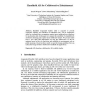Free Online Productivity Tools
i2Speak
i2Symbol
i2OCR
iTex2Img
iWeb2Print
iWeb2Shot
i2Type
iPdf2Split
iPdf2Merge
i2Bopomofo
i2Arabic
i2Style
i2Image
i2PDF
iLatex2Rtf
Sci2ools
ICAT
2006
IEEE
2006
IEEE
Handheld AR for Collaborative Edutainment
Handheld Augmented Reality (AR) is expected to provide ergonomic, intuitive user interfaces for untrained users. Yet no comparative study has evaluated these assumptions against more traditional user interfaces for an education task. In this paper we compare the suitability of a handheld AR arts-history learning game against more traditional variants. We present results from a user study that demonstrate not only the effectiveness of AR for untrained users but also its fun-factor and suitability in environments such as public museums. Based on these results we provide design guidelines that can inform the design of future collaborative handheld AR applications.
| Added | 11 Jun 2010 |
| Updated | 11 Jun 2010 |
| Type | Conference |
| Year | 2006 |
| Where | ICAT |
| Authors | Daniel Wagner, Dieter Schmalstieg, Mark Billinghurst |
Comments (0)

